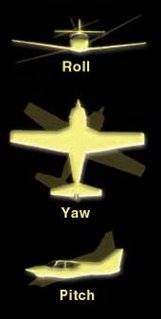What not to do with an airplane
As far as maintaining stability, I'm going to explain one of the worst things that can happen to an airplane in flight: spin. Aircraft spin accounts for 10 percent of all aviation accidents, and just under 14 percent of fatal accidents.For starters, airplane wings are designed so that over a certain incident airspeed (the velocity of the air travelling directly over the wing from front to back), the fluid pressures of the air flowing over the wing's surfaces cause lift generation, or an overall upward force. Below that speed, the wing doesn't generate any lift.
Because of this, every airplane has a specified "stall speed." You want your airplane to be flying faster than its stall speed, because otherwise the incident airspeed hits that magical point where the wing "stalls" -- it stops generating lift. (Airplanes don't fly very well when the wings stop generating lift.) The horizontal stabilizers (fins) on the tail of the airplane work the same way; usually, however, the stall speed for those is lower than for the wings. I'll explain why in a moment.
With that in mind, consider the case of an airplane flying straight and happy. If it slows to just below wing stall speed, the wings will lose lift and the airplane will sink. But the horizontal stabilizers, which are still above their stall speed, are still generating lift. This gives the tail some buoyancy relative to the rest of the airplane, so the airplane heads into a dive. Then the incident airspeed over the wings increases again, and -- *ta-da* -- the pilot can pull out of the dive back onto a level flight path and keep on humming along at a suitable speed. Thus, because of the horizontal stabilizer design, the natural reaction of the stalled aircraft is to dive, which provides the boost required to get the airplane flying again.
The dangerous kind of stall is not too far removed from that. In the case I just discussed, both wings stalled at the same time, so the loss of lift was symmetrical. If one wing stalls before the other, you have a real problem. (This can happen, for example, if you're flying just above the wing stall speed and you hit a wind gust the wrong way; you can also cause it deliberately by using the controls to swing the airplane's nose sharply to one side.)
 Let's say that the airplane is flying just faster than the wing stall speed, and the right wing stalls. Three things happen:
Let's say that the airplane is flying just faster than the wing stall speed, and the right wing stalls. Three things happen:1. The airflow over the stalled right wing isn't smooth anymore, so the drag on that wing increases, effectively pulling back on that wing relative to the rest of the airplane; this causes the airplane to "yaw" to the right (the nose swings over in that direction) and enter into a spin.
2. The stalled right wing loses lift, but the left wing is still lifting. This sends the airplane into a roll as the right wing sinks.
3. Because the right wing is no longer generating lift, the total lift provided by the wings has been cut in half. The horizontal stabilizers, just like before, keep lifting the same amount as always; but because the wings are producing less lift than usual, the body of the airplane will start to sink while the tail is more "buoyant" than the rest of the airplane. This sends the airplane pitching nose-down.
At this point the airplane is in what we call "developed spin" and losing altitude fast. Recovering from this kind of spin, if this specific aircraft is able to do so (and they aren't always), requires that the pilot keep a cool head and follow prescribed spin recovery procedures.
--
Labels: engineering

